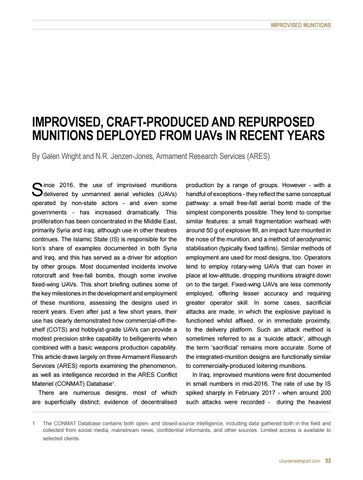IMPROVISED MUNITIONS
IMPROVISED, CRAFT-PRODUCED AND REPURPOSED MUNITIONS DEPLOYED FROM UAVs IN RECENT YEARS By Galen Wright and N.R. Jenzen-Jones, Armament Research Services (ARES)
S
ince 2016, the use of improvised munitions delivered by unmanned aerial vehicles (UAVs) operated by non-state actors - and even some governments - has increased dramatically. This proliferation has been concentrated in the Middle East, primarily Syria and Iraq, although use in other theatres continues. The Islamic State (IS) is responsible for the lion’s share of examples documented in both Syria and Iraq, and this has served as a driver for adoption by other groups. Most documented incidents involve rotorcraft and free-fall bombs, though some involve fixed-wing UAVs. This short briefing outlines some of
production by a range of groups. However - with a handful of exceptions - they reflect the same conceptual pathway: a small free-fall aerial bomb made of the simplest components possible. They tend to comprise similar features: a small fragmentation warhead with around 50 g of explosive fill, an impact fuze mounted in the nose of the munition, and a method of aerodynamic stabilisation (typically fixed tailfins). Similar methods of employment are used for most designs, too. Operators tend to employ rotary-wing UAVs that can hover in place at low-altitude, dropping munitions straight down on to the target. Fixed-wing UAVs are less commonly
the key milestones in the development and employment of these munitions, assessing the designs used in recent years. Even after just a few short years, their use has clearly demonstrated how commercial-off-theshelf (COTS) and hobbyist-grade UAVs can provide a modest precision strike capability to belligerents when combined with a basic weapons production capability. This article draws largely on three Armament Research Services (ARES) reports examining the phenomenon, as well as intelligence recorded in the ARES Conflict Materiel (CONMAT) Database1. There are numerous designs, most of which are superficially distinct; evidence of decentralised
employed, offering lesser accuracy and requiring greater operator skill. In some cases, sacrificial attacks are made, in which the explosive payload is functioned whilst affixed, or in immediate proximity, to the delivery platform. Such an attack method is sometimes referred to as a ‘suicide attack’, although the term ‘sacrificial’ remains more accurate. Some of the integrated-munition designs are functionally similar to commercially-produced loitering munitions. In Iraq, improvised munitions were first documented in small numbers in mid-2016. The rate of use by IS spiked sharply in February 2017 - when around 200 such attacks were recorded - during the heaviest
1 The CONMAT Database contains both open- and closed-source intelligence, including data gathered both in the field and collected from social media, mainstream news, confidential informants, and other sources. Limited access is available to selected clients.
counteriedreport.com
53
